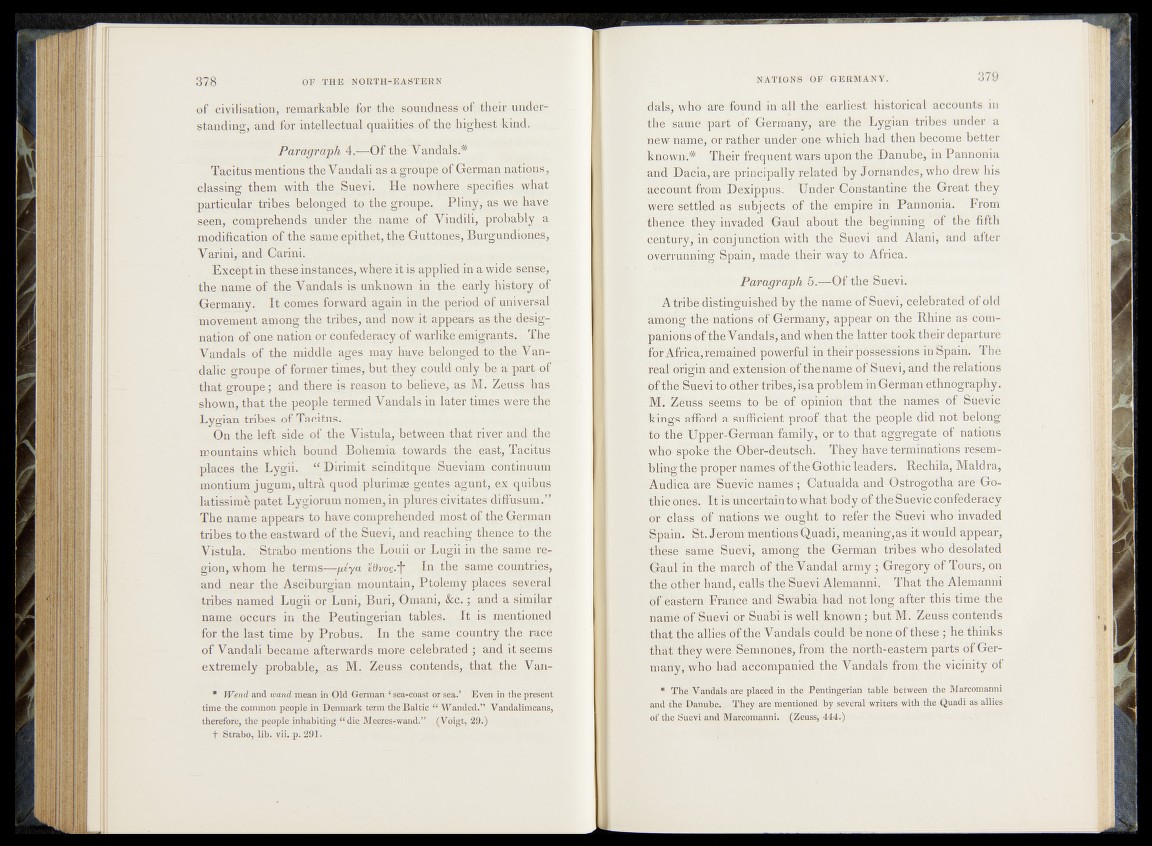
of civilisation, remarkable for thejsoundness-,of their-understanding,
and for intellectual qualities of the highest kind.
- Paragraph 4.r^-Of the Vandals.*
Tacitus mpntiops the Vandali as a gnoup^'of German nations,
classing them, with the Bqqyh He nowhere ,.specifies what
particular tribes |belopge^to the groupe.. Pliny, aj^yje have
seen, coipprehends under tJae^nam^pf Vindili, probably a
modification of the same epithet, the Guttffle^yBurg.undionfiS,
Varinh and Carini,.
Except in these instances, where it ^applied in ayvid© |erijse,,
the-name of the Vandals is unknown in th p e a rly history of
Germany. I t comes forward again inj&eg&$Lod fff universal
movement among the tribes, and now it .appears as -the ,^§sig-
nation of .one nation or confederacy of y ^ S ^ e^Mrants. The
Vandals, .of the middle ages may'have-bmonJ|lh to the Van^
d a liq p o u p e of former times, but- they nouJd-Wl^b^ a part of
that groupe;" and therejs reason to ^ h e ljem ^ M/Z^SBMbgs
shown, that tfip e o p le termed Vandals in la tg rJii^ a jy ^ .lhe
Lygian tribes of Tacitus. .
On the left side of the Vistula, between.that.-riyer aud^the
mountains which bound Bohemia towa-rds.^theJea^t. Xacjtus
places the Lygii. “ Dirimit .sciriditque tSueviam continuum
montium jugum, ultrd quod pluriiqse g e n te |^ ^ t,^ e x quihhjgi
latissim^ patet Lygiorum nomen, in phL^re^yi^te|ldiffusunI^^,
The name.appears to have comprehended .rriost of the.Qermari
tribes to the eastward of the Suevi, and reaching tb ^ d e j^ th e
Vistula., Strabo mentions the Louii or Lugii in the same jre-
gion^wbom he derms-^eya eOvogsf In the sanje,^||untries,
and near the Ascibuigian mountain, Ptolemy plapes^seyeral
tribes named Lugii or Luni, Buri, Omani, & c .a n d a similar
name ..occurs in the Peutingerian tables... It isJ5 mentioned
for the last time by Probus. In the samp country the race
of Vandali became afterwards more celebrated ; and it seems
extremely probable, jas M. Zeuss# contends, that the Van-
* W e n d and w a n d mean inOld German ‘ sea-coast or sea.’ Even in the present
time tbe common people in Denmark term the Baltic ee Wanded.” Yandalimeans,
therefore, the'people inhabiting (i die. Meeres-wand.” (Voigt, 29.)
f Strabo, lib. vii. p. 291.
dais, who are foundrin all the earliest historical accounts in
the same part of Germany, are the Lygian tribes under a
new name, or rather under ,ope which had then become better
known.* Their frqquent wars upon the Danube, in Pannonia
and Ba’di^ are prihöfc'ally relpfeWlly ’Jornandes, who drew his
ucdountdrom Dexippu^'’'y%nder Constantine the Great they
were scÉtled a's^s’ubj edtll^of the empire in Pannonia. From
lbe'nóh' they invaded JGauf'abouf t nff /b é$ nning*of the fifth
urv with the Suevi and Alani, aha after
ovèl-J-unhi’ng^Spain/.madmptteir way to Africa.1'
Paragraph fer^Of the Suevrtó
A'frft^^istin^uÖhed by the name'of Sudvi,JcfeMbrated of old
èhion^dhdrifd%érf#'of Gerfriany,'appèar on the Rhine'ab com-
pafiiörtsdf the V andalsfj^hd whën the'lidtltef took their departure
forAfthfa,r emXiried powerful iri'thfeirTOfsie^iohs inSpain. The
.real* <^^if^'and^ëxtëhs'iört"of the name of suevi,'' and the relations
.dfthe Suevi tfc>' ótheï fribes^ishplroBre^i^h Gêrinan ethnography.
M: "to da#‘o f opinion!* th at * the naniës^of • Suevic
kings hiPord^a sufficilm pfStlf thaClffi'p'eoplef^did not belong
to’thÖ tipper-airman family^ or to thaf ■u^gffegafe óf nations
Wh^ spbkè'the Ober-deutsch. Theyhh'Yeterminations resem-
;F)1 i&lg tifh p roper hllmd|' of the Gothic leaders: Rechila, Maldra,
A l l i t p V e ’Siiè^Sriamies1; Catualda a n d ^ ltro g o th a are Gothic
on^.. It is!uncertain to what body of thhB'uevicc'drifederacy
if^ h k s s óf ‘.hafidfis Vesdni^hf id!; refer' the SdÓ^l who invaded
Spain. St. J èrb'ïh mentions Quad!; meaning,;a!s it would appear,
thOse^samo^Suyviy amón'g dhe^Ghrïüan trihèi% ho^ifesblated
Gèlul.ïn the march 'o f the Vandal' army l‘ Gfeghfy of Tours, on
th i othefhand, calls th e ^C T ^ lem anm . That th e Alelrianni
ofp&stern France and Swabia had riot lorig'uftèr this time the
natMof:$ue^i Ör ÖuaM is well kriotvri; but M. Zeih^ contends
that the alliel o f the'Vandals pou^qe'hórië of thfes^,'he thinks
th a t they wérê "Semnones, from thé riorth-Oastérn parts of Germany,
who' bad accdmpanied trie wanaals from, theWicinity df
* The Vandals are placed in the Pentingerian ■ table between the Marcömamu
and the Danube. s>They'are baentioned by several writers with the Quadi as allies
of the Suevi and Marcomanni. (Zeuss, 444.) ' •